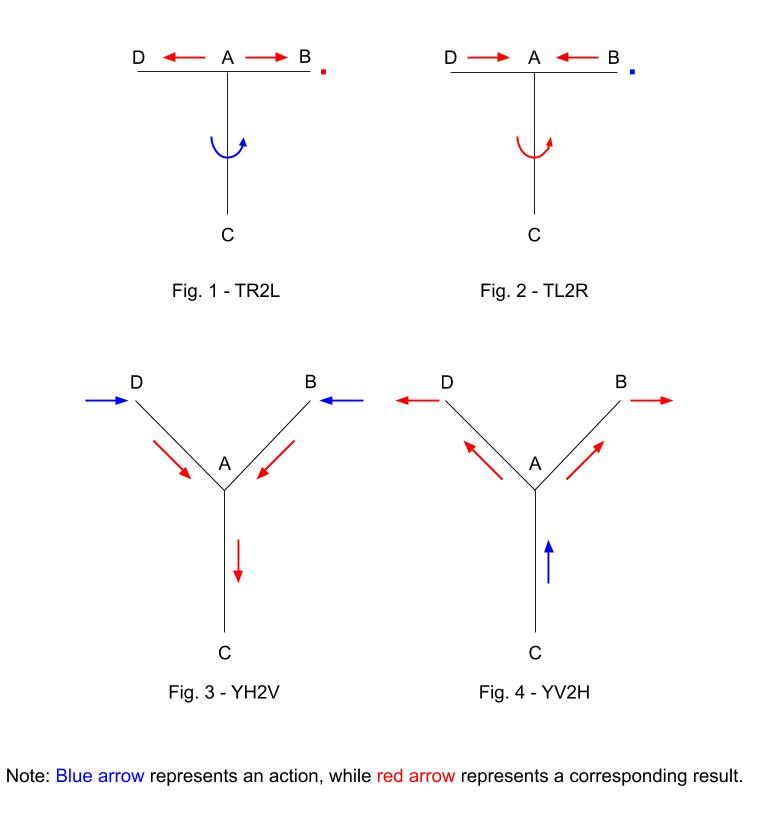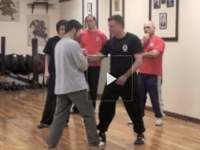
The main principle of Practical Method is:
- Separation of yin and yang
on which all cencepts and actions are based.
The major concept of Practical Method is:
- Indirect power
There are two categories of actions:
- Lock the two ends, move the middle.
- Lock the middle, move the two ends.
In order to have indirect power, actions go through two classes of power conversions:
- T class
- Y class
These classes can be further broken down into four types:
- TR2L – When an action is rotational, the result is linear.
- In Fig. 1, when rotating on the AC line, energy goes out from A to B and D. The result is tangential to the AC rotation at B (going into the page).
- The direction of the rotation on the AC line can be reversed, causing the tangential move at B to be reversed.
- Category: Lock the two ends, move the middle.
- Example: Spinning a rattle drum.
- TL2R- When an action is linear, the result is rotational.
- In Fig. 2, when moving B around A while A is not moving, the energy goes from B to A. The result is rotation on the AC line
- The direction of how B moves around A can be reversed, causing the direction of the rotation on the AC line to be reversed.
- Category: Lock the middle, move the two ends..
- Example: Turning an auger
- YH2V – When an action is horizontal, the result is vertical.
- In Fig. 3, when B and D move towards each other, the energy will go torwards A. The result is the AC line moving downwards.
- B and D can move away from each other instead, causing the the AC line to move upwards.
- Category: Lock the middle, move the two ends.
- Example: Squeezing a tooth paste
- YV2H – When an action is vertical, the result is horizontal.
- In Fig. 4, when AC line moves upwards, the energy will go from A to B and D. The result is B and D will move away from each other.
- The AC line can move downwards instead, causing B and D to come together from each other.
- Category: Lock the two ends, move the middle.
- Example: Open and closing an umbrella
Actions as described in T and Y classes of power conversions can be combined.
- Rotating one gear that is attached to another is TR2L + TL2R.
- Opening an umbrella while turning it is TR2L + YV2H.
- Unscrewing a cork from a wine bottle is TL2R + YV2H.
Looking the T bar from the top is a simple lever between B and D with A being the pivot.
DAB in the Y bar form a triangle as described in:
http://practicalmethod.com/2014/07/triangle_double_lock_single_lock/.



{ 7 comments… read them below or add one }
Acronyms
TR2L = T Rotational To Linear. [Class] T class – [Action] Rotational – [Result] Linear.
TL2R = T Linear To Rotational. [Class] T class – [Action] Linear – [Result] Rotational.
YH2V = Y Horizontal To Vertical. [Class] Y class – [Action] Horizontal – [Result] Vertical.
YV2H = Y Vertical To Horizontal. [Class] Y class – [Action] Vertical – [Result] Horizontal.
Great article! There appears to be typos in the latter two acronyms of the last two examples:
“2. Opening an umbrella while turning it is TR2L + YV2R.”
“3. Unscrewing a cork from a wine bottle is TL2R + YV2R.”
No, there were no typos for what I intended. These 3 examples were meant to provide the idea of mixing and matching two or more of the four types.
Rotating one gear that is attached to another is TR2L + TL2R.
This first example was interesting in a way that we start with a rotation with one gear, and ends with a rotation on another gear.
The + sign actually has different means in the different examples. It is sequential in the gear example, but it is simultaneous in the umbrella example.
Thanks for the clarification Kelvin. Could you please explain further the second example of Opening an umbrella while turning? After thinking through it, I thought it would be TR2L + YV2H.
YV2R should instead be YV2H. Thanks.
Wow, this ist brilliant Kelvin. It gave me a lot to think about. After some time I contemplated on a variant of fig. 4. You could also move (pull) B and D and as a result AC moves upwards. It sometimes happens in push hands and is a good method to triangulate the center of the opponent. But I’m not sure that counts as power conversion in your sense here. Maybe that is a special case of lock the middle, move the two ends. There is a childrens toy that would be a example for this when attempting to throw it (https://en.wikipedia.org/wiki/Diabolo). Or stretching of some cloth or rubber band. Its atleast an indirect move.
> You could also move (pull) B and D and as a result AC moves upwards.
Yes, it will be the case with a | put inside a V for what you described. It is horizontal converted to vertical. It is basically how a trampoline works.
Thanks for your comment.